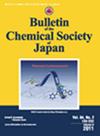明亮硅量子点合成与 LED 设计:从慢带和快带工程中洞察尺寸-配体-性能关系
IF 3.3
3区 化学
Q2 CHEMISTRY, MULTIDISCIPLINARY
引用次数: 1
摘要
多色、明亮的硅量子点(SiQDs)--具有各种颜色的光致发光且量子产率(PLQYs)大于 90%的硅量子点--是一种很有前途的无重金属光源,可用于全彩显示、照明和生物医学成像。胶体 SiQDs 可用于通过印刷和卷对卷加工制造设备。此外,可生物降解的 SiQDs 和硅纳米材料已被证明可用于体内癌细胞成像和药物输送系统。然而,大量研究表明,胶体 SiQD 的光致发光(PL)波长和 PLQY 不仅取决于 SiQD 的粒径,还取决于合成 SiQD 的方法和/或程序以及化学试剂。这是因为 SiQD 对硅的内在特性和外部因素都相当敏感。这些内在和外在因素可分别与不同的聚光机制相关联:产生慢衰减 "S "带聚光信号的量子束缚效应和与快衰减 "F "带聚光相对应的表面配体效应。本综述侧重于从机理上深入探讨 SiQDs 的结构、配体和光学特性之间的关系。此外,还综述了基于最新实验和理论研究的明亮多色胶体 SiQDs 的合成方法和应用性能。本文章由计算机程序翻译,如有差异,请以英文原文为准。
Bright silicon quantum dot synthesis and LED design: insights into size–ligand–property relationships from slow- and fast-band engineering
Multicolor, bright silicon quantum dots (SiQDs)—SiQDs with photoluminescence in a range of colors and quantum yields (PLQYs) of >90%—are promising heavy-metal-free light sources for full-color displays, lighting, and biomedical imaging. Colloidal SiQDs can be used to manufacture devices via printing and roll-to-roll processing. Furthermore, the in vivo use of biodegradable SiQDs and Si nanomaterials, for imaging cancer cells and as drug delivery systems, has been demonstrated. However, a large body of research demonstrates that the photoluminescence (PL) wavelength and PLQY of colloidal SiQDs are dependent not only on the SiQD particle size but also on the methods and/or procedures and chemical reagents used to synthesize them. This is because SiQDs are quite sensitive to both the intrinsic properties of Si and external factors. These intrinsic and external factors can be respectively linked to different PL mechanisms: the quantum confinement effect, which produces a slow-decaying “S”-band PL signal, and surface ligand effects, corresponding to fast-decaying “F”-band PL. This review focuses on mechanistic insights into the relationships linking the structures, ligands, and optical properties of SiQDs. Synthesis methods and the application performance of bright multicolor colloidal SiQDs, based on excellent state-of-the-art experimental and theoretical studies, are also reviewed.
求助全文
通过发布文献求助,成功后即可免费获取论文全文。
去求助
来源期刊
CiteScore
6.40
自引率
5.00%
发文量
194
审稿时长
3-8 weeks
期刊介绍:
The Bulletin of the Chemical Society of Japan (BCSJ) is devoted to the publication of scientific research papers in the fields of Theoretical and Physical Chemistry, Analytical and Inorganic Chemistry, Organic and Biological Chemistry, and Applied and Materials Chemistry. BCSJ appears as a monthly journal online and in advance with three kinds of papers (Accounts, Articles, and Short Articles) describing original research. The purpose of BCSJ is to select and publish the most important papers with the broadest significance to the chemistry community in general. The Chemical Society of Japan hopes all visitors will notice the usefulness of our journal and the abundance of topics, and welcomes more submissions from scientists all over the world.

 求助内容:
求助内容: 应助结果提醒方式:
应助结果提醒方式:


